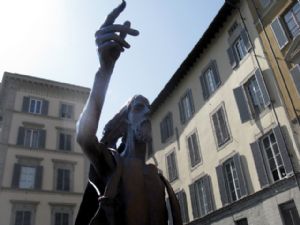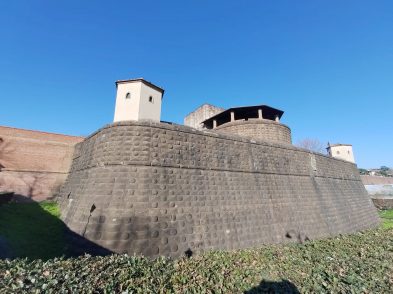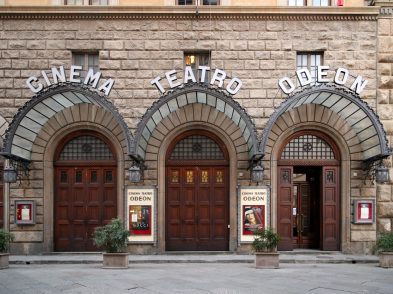Given to the city by the Cassa di Risparmio di Firenze in 1996, the bronze statue of St. John the Baptist, Florence’s protector and patron saint, sculpted by Giuliano Vangi stands in piazza Santa Maria sopr’Arno, in the small triangular square between via de’ Bardi and lungarno Torrigiani. Two meters tall, Vangi’s statue of the saint is unique and evocative. The gaunt, almost emaciated, full-length figure looking towards Ponte Vecchio has his right arm raised, pointing his famous finger. His clothing (a short undergarment and rough-hewn cloak lined with camel hair and tied with intricate rope cording) and his bare feet, long hair and beard recall his days in the desert.
Vangi’s sculpture is the most recent of the many depictions of St. John the Baptist around town. The two most familiar sculptures (both now copies) are the one above the north door of the Baptistery, which is named after him, in piazza Duomo, and Lorenzo Ghiberti’s fifteenth-century statue in an external niche of the church of Orsanmichele. The Chiostro dello Scalzo (via Cavour, 69) also contains a beautiful fresco cycle of his life.

St. John the Baptist is much loved in Florence, which, every year, on June 24, celebrates his feast day with a holiday full of colourful events. The celebrations begin with a deputation from the illustrious Società di San Giovanni paying its respects to the mayor. The members of the Società di San Giovanni (which, in 1796, was first entrusted by Grand Duke Ferdinand III of Tuscany with protecting the artistic and cultural heritage of the city and preserving its historical traditions) then lead a procession of flag throwers and others in Renaissance costumes to the Baptistery. There, they offer candles and a precious relic of St. John is displayed. This holy object is said to be the index finger of St. John’s right hand with which he pointed at Herod, Rome’s puppet ruler of Judaea, accusing him of his incestuous marriage to his brother’s former wife and his own niece. Mass in the Duomo follows, and, in the afternoon, the final game of historic football in costume is held in piazza Santa Croce (see TF 145, 165). Later, there is a rowing competition along the Arno river (another sporting event, the night-time marathon known as la notturna, is usually run a few days before). Finally, at 10pm, magnificent fireworks, organised and paid for by the Società di San Giovanni, are launched from piazzale Michelangelo, their lights mirrored in the river below.
The city has had other symbolic protectors. In Roman times, Mars, the god of war and guardian of agriculture, was considered the protector of Florence and a statue to him stood by the Ponte Vecchio until 1333, when it was swept away in a flood. When, in the second century CE, Christianity arrived in Florence, it came with Greek merchants from Syria who established the first Christian colony on the site of the church of Santa Felicità, near Ponte Vecchio. They venerated early Christian martyrs, among them St. Steven, St. Felicity and St. Reparata, to whom the city’s first cathedral was dedicated, and, in particular, St. John the Baptist, whom the Florentines elected as their patron saint. They also dedicated the Baptistery, constructed on the site of the old Roman thermal baths, in front of the cathedral, some say in the fifth century, but more likely in the eleventh century, to him. It was, in fact, consecrated in 1059 and, in the thirteenth century, the primitive circular apsis in the presently existing rectangular tribune, the attic and skylight turret were added.
Why then was St. John the Baptist so appealing to medieval Florentines? According to Christian beliefs, St. John the Baptist was the prophet who recognised Jesus as the Messiah and baptised him. With many followers, he was resolute and inflexible in his preaching, as shown by his courage in openly denouncing Herod, who took his revenge by beheading his accuser. His intrepidness appealed to the Florentines as it was similar to that of the bellicose Mars. So great was their admiration of him that, from 1252 onwards, the holy man’s image was engraved on one side of the golden florin, as if to suggest a warranty that the coins contained the 3.5 grams of gold they were supposed to.
Vangi, creator of this most recent portrayal of the city’s patron saint, was born in Barberino di Mugello, not far from Florence, on March 13, 1931. After studying at the Istituto d’Arte and the Accademia di Belle Arti in Florence, he taught from 1950 at the Istituto d’Arte in Pesaro until, in 1959, he went to Brazil, where he lived for three years. His work, which employs many different materials, can be found, for instance, in the Vatican as well as the Pisa and Arezzo cathedrals. He has shown widely, exhibiting at Fort Belvedere (a retrospective in 1995), the Uffizi (2000), the Hermitage Museum in St. Petersburg (2001) and the Open Air Museum in Hakone, Japan (2001). His popularity in Japan is such that, in 2002, the Vangi Sculpture Garden Museum was opened near Mishima City, making him one of the very few living sculptors in the world to have a museum named after him. It permanently exhibits many of his drawings and sculptures, with larger pieces found outdoors in its surrounding park. Conceivably, as a man of nature and a visionary, St. John the Baptist would have liked that.
Learn more about the Società di San Giovanni at www.sgiovannibattista.com
For information about the Vangi Sculpture Garden Museum, see www.vangi-museum.jp/e/







